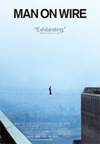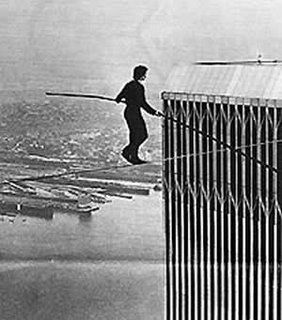2008
Main Movie
Page
Atonement
Boy in the Striped Pajamas
Brideshead Revisited
Counterfeiters
The Dark Knight
Enchanted
Frozen River
Indiana Jones and the Kingdom of the Crystal Skull
Iron Man
Juno
Man on Wire
Michael Clayton
No Country
for Old Men
Rachel Getting Married
the Savages
The Secret Life of Bees
Sweeney Todd
There Will Be Blood
The Visitor
WALL-E
Film
Reviews from 2007
Film Reviews
from 2006
On August 7, 1974, Frenchman Philippe Petit walked into the sky on a wire connecting the Twin Towers of the newly built World Trade Center. Watching the original film of this event, even with its grainy quality, is breathtaking. How could he do it, with the wind swirling around him and no net to catch him? Not only does Petit walk across, he sits on the wire, kneels, walks backward, takes his time, clearly enjoying the moment. It’s an act of total concentration and belief in oneself. While police await him on both sides, Petit toys with them, walking back across the abyss, while spectators watch from below. It’s like something out of a silent movie with Harold Lloyd or Buster Keaton. Even the arresting officer calls the feat an act of beauty.
Man on Wire, directed by James Marsh, recounts the story of Petit’s life, from his childhood dream, when he sees a photo in a magazine in a dentist’s office, to present day, as he reminisces about the 1974 event. A long sequence entails the few days leading up to August 7, 1974, carrying his equipment to the top of the Tower under the nose of a security guard. For the amount of time Marsh spends with the preparation for August 7, I still did not understand how he and his accomplices spanned the wires from one building to the other. I felt like I had missed something here. Marsh also includes interviews with family members and colleagues who encourage and work with Petit. Some are more interesting than others, but, on the whole, the interviews did not help me to understand Petit and his mission. I began to find them tedious. Perhaps the point is that, as with all vocations in life, Petit’s call cannot rationally be explained. He just knew what he wanted to do in his life. Despite its weaknesses, when we see Petit walking through space on a thin wire, knowing this was real and not a special effect, it does take the breath away. While I watched in amazement, there is not a moment that I did not think of the horrible events at the same location 27 years later. Rather than being amazed at a harmless act of absurd beauty, the world watched in shock at the death and destruction. Without one scene or reference to 9/11, it’s always there in the background, impossible to escape. It is this quality of irony that lifts up Man on Wire beyond that of an account of one man’s death-defying act. Tom Condon, OP |
The USCCB Office for Film & Broadcasting has not reviewed this film. |
subscribe to
DomLife.org and receive a free email update every two weeks. unsubscribe |




 Petit sees his wire walk as a calling, a vocation. He knows that’s
what he has to do with his life. It’s also a work of art,
inspiring awe among spectators. His action is an absurdly daring
act of beauty in the chaotic world of the 70’s. The Twin
Tower walk is the culmination of his career, with previous walks across
the spires of Notre Dame Cathedral and the Sydney Harbor Bridge.
Petit sees his wire walk as a calling, a vocation. He knows that’s
what he has to do with his life. It’s also a work of art,
inspiring awe among spectators. His action is an absurdly daring
act of beauty in the chaotic world of the 70’s. The Twin
Tower walk is the culmination of his career, with previous walks across
the spires of Notre Dame Cathedral and the Sydney Harbor Bridge.